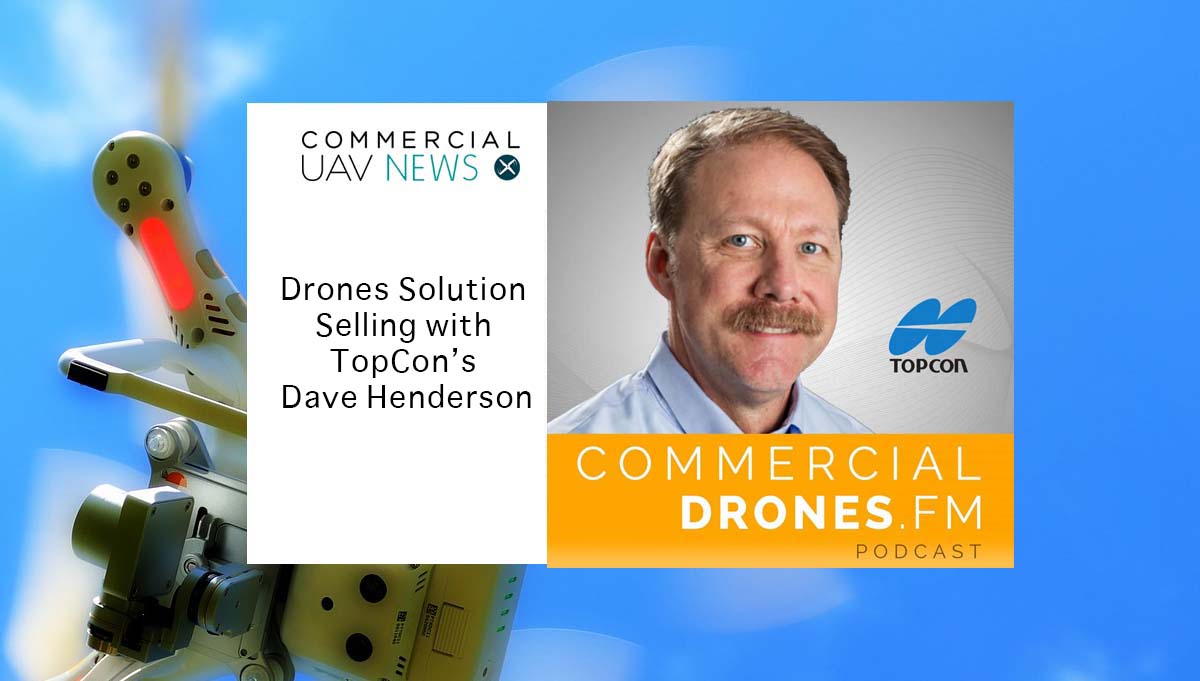Dave Henderson has talked through what it means to use drones to help create a positive ROI, and his approach around doing so is not only based on his history in the surveying space, but also on how Topcon Positioning Systems was able to enter the drone market. As Director of Sales, Geospatial Solutions, for TopCon, Henderson has an incredible understanding of the issues that users and organizations are struggling with, and these insights have been able to help him cut to the core of the challenges they’re working through.
Exactly what that means to Henderson and his customers is something that was discussed in detail during episode #65 of the Commercial Drones FM podcast – Drones Solution Selling with TopCon’s Dave Henderson. Host Ian Smith sat down with Henderson at the Commercial UAV Expo, and the two talked through the questions that he asks his clients to help him and them understand what it will means for them to adopt a solution that’s going to make sense.Henderson’s focus has been to specialize in assisting businesses, organizations and individuals to implement technology into existing workflows, and we caught up with Ian to find out what kind of challenges he’s seen in these areas, as well as whether or not TopCon’s perspective around drones is especially different because of how they entered the market. Read through the additional insights before or after listening to the podcast below. You can also listen to the episode on iTunes or GooglePlay. Jeremiah Karpowicz: Hearing Dave talk about the physical blueprints he dealt with really underscores the kind of shift from an analog world to a digital one that so many industries are going through. It’s obviously not a trend that’s going to change or reverse, but do you think organizations or even entire industries are losing anything with this shift? Or maybe a better question ask is what advantages associated with analog should we work to ensure carry over to digital? Ian Smith: It's a big shift when moving from mainly analog to digital. This is likely something that will only affect our current generation, though. With that said, analog has huge advantages in some cases. I often hear about construction sites who are using drones on the project that want to create weekly, digital orthomosaics and then have them printed out on large posterboard so that they can have an easily-referenceable, persistent map of the site available and tangible whenever needed. Sometimes there's just no replacing analog. TopCon entered the drone market through partnerships, which is different from the “buy or build” approach that so many organizations have taken. What does that tell you about TopCon as an organization, and what does the fact that the companies TopCon partnered with have both been acquired by Intel?Good observation. TopCon seems like an interesting company and definitely has more of the value-added reseller approach, augmented with their own software products as well as hardware. TopCon already has an established customer base of legacy GIS and surveying products so for them it likely made more sense to augment their existing product line with drone technology rather than building it themselves. That decision has probably made it much easier for them to stick with UAS as a product category. If you look at Trimble, they bought a drone company (Gatewing) and then later sold it to Delair, a "pure" drone company. TopCon's approach for partnerships and reselling seems to have made this more economical for them—they also seem to have chosen great partners from the outset, given the Intel acquisitions! That question of, “how does all this data work together?” is one that Dave asks his clients and prospective clients in several different ways, and being able to frame all of that in terms of what someone is or isn’t currently doing helps him figure out what solution might be the best fit for them. Are the potential commercial users you talk with often ready to discuss these sorts of details, or are they more focused on drone technology itself? It all depends on the company and their level of integration with other technologies. The larger the company, the more they're going to want everything to work together, from a data standpoint. Smaller companies are more flexible but they have more on the line. As more and more software providers move into the cloud, integrations and APIs become the cornerstone of adoption for lots of organizations. Predictions about the role the autonomous capabilities of drones are something we’ve heard a lot of people talk about, and it’s clearly something Dave is keeping an eye on as well. Will taking advantage of the autonomous capabilities of drones in the near future be more of a technical issue or a regulatory one though?This is definitely a regulatory issue. As soon as the FAA flips the switch on allowing autonomous, BVLOS, nighttime ops, there will be more (technically capable) drone-in-a-box systems out there than you can shake a stick at. The technology piece of the equation is all but solved—and has been for some time—but the market demand is not there yet, due to regulations.Subscribe
The information you submit will be stored and used to communicate with you about your interest in Commercial UAV News. To understand more about how we use and store information, please refer to our privacy policy.
April 3, 2018
How TopCon Entered the Drone Market - Commercial Drones FM Podcast Insights
















Comments